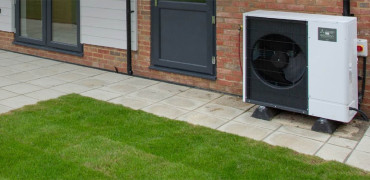Heat networks comprise a network of pipes which can supply heating or cooling to multiple buildings simultaneously. The network derives its energy from a central heat source or ‘energy centre’. There are currently over 14,000 of them in the UK.
Heat networks are not a new concept and have been installed in the UK since the 1950s.
They are much older than that though and the largest example still in use worldwide is New York’s City Steam System, which has been in operation since 1882, and which is why you can still see the iconic shots of steam rising from below ground in parts of Manhattan.
First generation heat networks operated at temperatures of 200°C and used coal and steam as their heat sources. However, they have been through several different generations since then, with heat networks evolving to reduce heat loss and now able to operate at much lower temperatures.
To meet government targets, these heat network zones will become increasingly common
Ambient heat sources
Today’s 5th Generation heat networks can operate efficiently at ambient temperatures of 45°C or less, and they can use many different kinds of low-carbon heat sources, such as water via heat pumps and solar thermal.
As an example, the Kingston Heights development, which was opened in 2014, by then Secretary of State for Energy and Climate Change, Ed Davey, uses the River Thames as a heat source for 137 apartments which are over 200 meters from the river.
There are two different types of heat network, which CIBSE describes as:
1. Communal Heat Networks: ‘The distribution of heat from a central source… to multiple dwellings in a single building’
2. District Heat Networks: ‘The distribution of heat from a central source… to multiple buildings or sites’
In both instances, Heat Interface Units (HIUs) are commonly used to transfer heat into each building connected to the network, which provide heat to the building’s heating system (e.g. radiators or underfloor heating).
The benefits of heat networks
There are a several benefits that come with heat networks:
- Reducing boiler dependency: As heat networks are centralised systems, they eradicate the need for individual boilers or electric heaters in every building or apartment.
- Efficiency: They enable the use of heat from a wide range of energy sources, including waste industrial heat, bodies of water, and even sewage, effectively utilising and transferring heat energy which would otherwise have been lost.
- Reducing carbon emissions: As heat networks can reduce carbon emissions by recovering low-carbon heat, they will play an important role for the UK going forward. The government’s ambition is for heat networks to have a 20% share of the heat market by 2050 (a significant increase from its 3% share in 2022).
- A newly regulated market: The heat network market was previously unregulated, meaning they could differ in design, efficiency standards and consumer protection (causing some consumers on inefficient heat networks to be left with extortionate energy bills). Ofgem, however, has begun regulating heat networks, with regulations launching in January 2026.
The government has also introduced the Heat Network Technical Assurance Scheme (HNTAS), which sets out the technical requirements to enhance heat network efficiency, as well as lower costs for operators and consumers. The Building Engineering Services Association (BESA) currently provides a training course to support this scheme.
And the challenges
While this all sounds promising in a decarbonising world, heat networks also carry several challenges:
- Cost: The cost of installing and maintaining heat networks can be very high. However, there are government-funded schemes available to help with this as you can read about further on.
- Skills shortage: If the UK is to reach its target of a 20% heat market share for heat networks by 2050, the number of skilled professionals needed to design, install and maintain them will need to increase to meet this demand.
- Heat network zoning: Buildings in designated heat network zones do not have a choice but to be connected to a heat network. Not all heat networks have a low-carbon heat source, which means buildings connected to them may struggle with decarbonisation strategies'
Low-carbon heat network grant funding
Low-carbon heat networks can be very costly to install and maintain. To help with this, there are several government-funded schemes that can be applied for:
The government’s Heat Network Transformation Programme (HNTP) offers different schemes to develop new heat networks and improve existing ones.
1. The Heat Network Efficiency Scheme (HNES): This £77m grant support scheme aims to improve heat network performance in instances where customers/ operators are experiencing sub-optimal outcomes.
2. The Green Heat Network Fund (GHNF): With a total capital grant of £288m, this scheme provides capital grant funding to support the development of low and zero carbon (LZC) heating (and cooling) networks. The scheme supports both the commercialisation and construction of LZC heat networks, as well as the retrofitting and expansion of existing ones.
There are other regional grants such as Scotland’s Heat Network Fund (SHNF) for Scotland-based projects, and a grant of up to £500 per trainee is available for heat network training courses through The Heat Training Grant.
What opportunities do heat networks offer?
Heat networks offer a great opportunity for heat pumps, whether air source, ground source, or in the case of Kingston Heights, water source.
Commercial heat pumps such as the Ecodan CAHV units can be used as part of a communal heat network system, as seen at The Aaben in Leaf Street, Manchester. This 2017 development connects 105 apartments and townhouses to a heat network using eight Ecodan CAHV-P500YA air-to-water heat pumps. These provide hot water and heating to each apartment via a HIU in each dwelling. As The Aaben was designed with quality, comfort and energy efficiency in mind, this system was an ideal solution for the building.
The Aaben falls under Greater Manchester’s heat network zone (indicative zones where heat networks are expected to lower the cost and carbon of heat for buildings in English towns and cities).
Another more recent example is the Mirador on Western, which has just been built and uses CAHV air source heat pumps to feed Ecodan Hydrodan water to water heat pumps inside each of 23 stylish, high-end apartments.
The need for low carbon networks
To meet the UK government’s 20% target, these heat network zones will become increasingly common, and more of these will need to be low-carbon to meet the UK’s net zero target. In its 7th Carbon Budget, The Climate Change Committee recommends the following:
- Low-carbon heat networks should make up 9% of low-carbon heating systems installed by 2040.
- All heat networks should be converted to low-carbon heat sources by 2040.
These recommendations to government imply that there will be large opportunities in the heat network market for both new and retrofitted systems.
To give an idea of the current scale of the market in the UK – and the opportunity still to be realised, take a look at DESNZ and Barbour ABI’s Heat Networks Planning Database (HNPD).
Amy McEwen is a Policy and Public Affairs Graduate for Mitsubishi Electric




